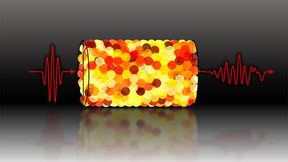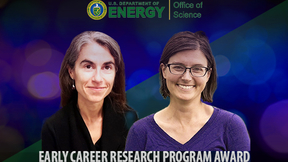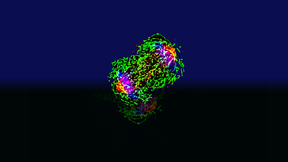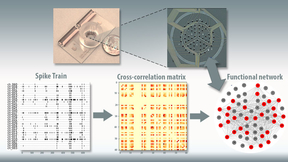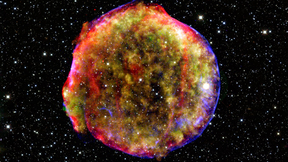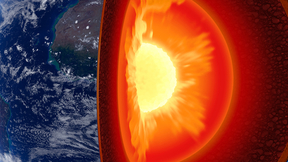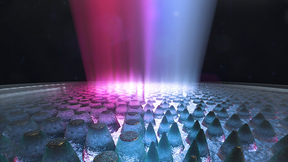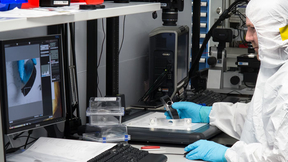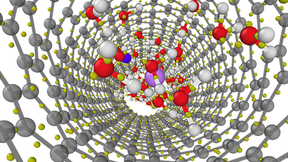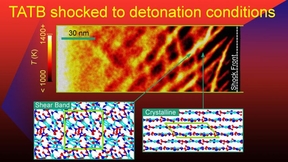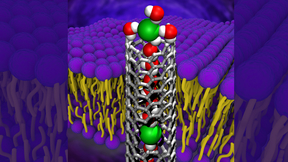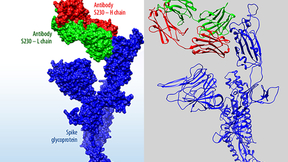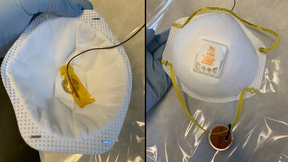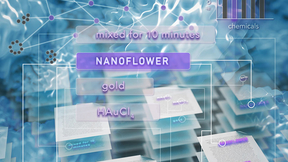Back
Physical and Life Sciences
Catching a wave to study granular material properties
Stress wave propagation through granular material is important for detecting the magnitude of earthquakes, locating oil and gas reservoirs, designing acoustic insulation and designing materials for compacting powders. A team of researchers including Lawrence Livermore National Laboratory (LLNL) physicist Eric Herbold used X-ray measurements and analyses to show that…
Plasma science report highlights workforce gap, calls for increased national commitment to future experiments
The National Academy of Sciences, Engineering and Medicine released an assessment of the state and future of plasma sciences last month. Commissioned by the Department of Energy, the National Science Foundation, the Air Force Office of Scientific Research and the Office of Naval Research, the report outlines recommendations for the advancement of plasma science and is…
DOE honors two early career Lab scientists
Two scientists from Lawrence Livermore National Laboratory (LLNL) are recipients of the Department of Energy’s (DOE) Office of Science Early Career Research Program award. Federica Coppari and Erin Nuccio are among 76 scientists nationwide selected for the recognition. Under the program, typical awards for DOE national laboratory staff are $500,000 per year for five years…
New way to study how elements mix in giant planets
There are giants among us — gas and ice giants, to be specific. They orbit the same star, but their environmental conditions and chemical makeup are wildly different from those of Earth. These enormous planets — Jupiter, Saturn, Neptune and Uranus — can be seen as natural laboratories for the physics of matter at extreme temperatures and pressures. Now, an international…
Signaling breast cancer metastasis
Metastasis accounts for approximately 90 percent of mortality in breast cancer patients. During the last few decades, there has been significant progress in understanding genetic, molecular and signaling mechanisms underpinning cancer cell migration. Biologists from Lawrence Livermore National Laboratory (LLNL) found another mechanism that affects the maintenance and…
Experiments expose how powerful magnetic fields are generated in the aftermath of supernovae
In a paper recently published by Physical Review Letters, a team of researchers including scientists from Lawrence Livermore National Laboratory (LLNL) detail the first quantitative measurements of the magnetic field structure of plasma filamentation driven by the Weibel instability, using a novel optical Thompson scattering technique. These experiments study the processes…
Modeling neuronal cultures on 'brain-on-a-chip' devices
For the past several years, Lawrence Livermore National Laboratory (LLNL) scientists and engineers have made significant progress in development of a three-dimensional “brain-on-a-chip” device capable of recording neural activity of human brain cell cultures grown outside the body. Now, LLNL researchers have a way to computationally model the activity and structures of…
Shock waves created at NIF mimic astrophysical particle accelerators powered by exploding stars
When stars explode as supernovae, they produce shock waves so powerful they can blast streams of particles called cosmic rays into the universe at nearly the speed of light. Yet the exact mechanisms behind these phenomena remained mysteries for decades. Now, in experiments at the National Ignition Facility (NIF), an international team of scientists from institutions…
Multi-lab research to improve COVID-19 diagnostics
In response to the ongoing need for COVID-19 testing, Lawrence Livermore National Laboratory (LLNL) biologists are part of a collaborative research effort focused on improving the speed and accuracy of diagnostic tests, while enhancing the ability to adapt diagnostic tools as the virus evolves. Currently, the fastest way to identify known pathogens is by using a DNA-based…
Checking out iron under pressure
Iron is the most stable and heaviest chemical element produced by nucleosynthesis in stars, making it the most abundant heavy element in the universe and in the interiors of Earth and other rocky planets. To get a better understanding of the high-pressure behavior of iron, a Lawrence Livermore National Laboratory (LLNL) physicist and international collaborators discovered…
Researchers Develop Novel Antireflective Metasurface for Laser Optics
LLNL scientists have discovered a new method to add an antireflective metasurface layer on laser optics glass.
NIF’s TARDIS Featured in Review of Scientific Instruments
A paper describing the design and performance of a workhorse NIF experimental platform known as TARDIS was a featured article in a recent edition of the journal Review of Scientific Instruments.
Pinpointing the effects of nanoconfinement on water
Researchers have spent decades studying the properties of water and how they change when there are disruptions to their normal behavior. Research on the topic has a wide range of applications, from biochemical systems to water desalination. A team of scientists from Lawrence Livermore National Laboratory (LLNL), Argonne National Laboratory and the University of Chicago…
Simulations explain detonation properties in TATB
Two Lawrence Livermore National Laboratory (LLNL) scientists have discovered a new mechanism for ignition of high explosives that explains the unusual detonation properties of 1,3,5-triamino-2,4,6-trinitrobenzene (TATB). The research will allow for systematic improvements to continuum mechanics models used to assess the performance and safety of the material accurately and…
AI identifies change in microstructure in aging materials
Lawrence Livermore National Laboratory (LLNL) scientists have taken a step forward in the design of future materials with improved performance by analyzing its microstructure using AI. The work recently appeared online in the journal Computational Materials Science. Technological progress in materials science applications spanning electronic, biomedical, alternate energy,…
Membrane nanopore transport gets picky
Trying to determine how negatively charged ions squeeze through a carbon nanotube 20,000 times smaller than a human hair is no easy feat. Not only did Lawrence Livermore National Laboratory (LLNL) scientists do that but they found that those ions are unexpectedly picky depending on the anion (a negatively charged ion). The research appears in ACS Nano. Inner pores of…
COVID-19 research goes public through new portal
To help accelerate discovery of therapeutic antibodies or antiviral drugs for SARS-CoV-2, the virus that causes COVID-19, Lawrence Livermore National Laboratory (LLNL) has launched a searchable data portal to share its COVID-19 research with scientists worldwide and the general public. The portal houses a wealth of data LLNL scientists have gathered from their ongoing…
LLNL team helps develop tularemia vaccine
Two Lawrence Livermore National Laboratory (LLNL) researchers who have worked for more than eight years to develop a tularemia vaccine are part of a three-institution team that has been funded to bring their candidate to readiness for use. The two biomedical scientists, Nick Fischer and Amy Rasley, will collaborate with scientists from the University of New Mexico and the…
Deactivating coronavirus on N95 respirators for reuse
Lawrence Livermore National Laboratory (LLNL) researchers are studying ways to safely and rapidly remove viral threats from N95 respirators, without compromising the device’s fit and its ability to filter airborne particles, so they can be reused. As seen during the COVID-19 pandemic, a shortage of personal protective equipment, including surgical masks and respirators,…
Building scientific insight through machine learning
A team of Lawrence Livermore National Laboratory (LLNL) materials and computer scientists developed machine learning tools that extract and structure information from the text and figures of nanomaterials articles using state-of-the-art natural language processing, image analysis, computer vision and visualization techniques. They are applying this technique to COVID-19…


